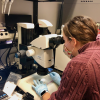High-throughput solutions for large-scale disease phenotyping.
We have established scalable, high-throughput phenotyping methods for characterizing human and mouse eye diseases. The mouse eye phenotype screening service is available to laboratories throughout the world. Through the development of cooperative laboratory networks, we hope to expand our screening effort.






